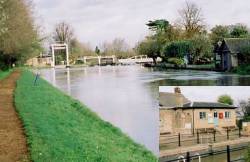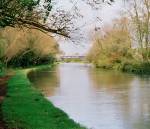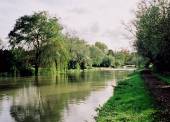Rowing at University in Cambridge
The Bumps
The Course
 |
||
| The bumps course in Cambridge and significant waymarks | ||
| |||||||||||||||
The bumps run from Baits Bite lock near Milton up-stream to Chesterton. The 18th boat in each division, starting from virtually in the lock, has to row some 800 m before it passes the head boat's station at the top of First Post Reach near First Post Corner.
The aerial photograph shows the whole bumps course - complete with the twists and turns and the names of significant waymarks.
| |||||||||||||||
The end of the course for the top half of each men's division (the first nine boats) is called 'top finish', and is the post just downstream of Chesterton Footbridge - a race distance of approximately 2200 m for the Head boat. The bottom half of each division have as far as 'Morley's Holt' to make their bump, which is marked by a post on the right hand bend after the railway bridge.
| |||||||||||||||
The women's courses are a little shorter - top finish being Peter's Posts (the posts just before the Pike and Eel pub), and bottom finish the upstream side of the railway bridge. It is a nice long course - much longer, for example, than the stretch of river available for racing in Oxford. An interesting twist is that each division's 10th crew may choose to continue to top finish if it wishes - i.e. if it is still chasing a bump.
In the Lent Bumps, the course for the 4th men's and 3rd women's divisions is much shorter, finishing at the first post in the reach or the railings.
 |
||
| The Long Reach (left) which runs to the railway bridge (right) | ||
Bumps evolved on the Cam because it is a narrow river, only wide enough for side by side racing for short sections. It is also a very twisty river, and has a number of sharp corners in the first half of the course. College boats on the Cam are fitted with large rudders to go round them, but learning how to race round corners is critically important particularly in bumps racing. Racing is also influenced heavily by wind conditions; whilst the first part of the course as far as Ditton corner is relatively sheltered, the 'long reach' (roughly the second half of the course) is a wide straight section of river running south-west, and in the Lent term in particular, often threatens strong head winds.
Exact bumps course distances can be found here.
For Spectators
Those planning to go and watch the bumps should go armed with a little advice on where to be and when... In the lower divisions bumps often occur quickly, with many boats typically 'bumping out' by First Post Corner. It is best to be standing somewhere near the top of First Post Reach, where you will see the spectacle of the start as well as a lot of bumping. Later in the day when the better crews race, boats are often more closely matched, and Grassy Corner is a popular view point, but many of the tougher races will extend atleast as far as the the reach. If you fancy a beer or two make your way towards The Plough - using the punt ferry during the Mays. Plough reach is also where most crews will do a 'practice start' (it might as well be for the spectators as much as for anyone else) during the procession of boats downstream before hand.
If you have never been before, here are some directions from the centre of Cambridge.
Next: How they work - divisions, the start, bumps and overbumps etc.








